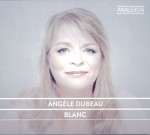 Angèle Dubeau and La Pietà are back with another CD of short contemporary works on BLANC (Analekta AN 2 8737), a disc very similar to her Silence, on joue! CD from two years ago. That the approach seems to work so much better this time is almost certainly due to the fact that BLANC celebrates Dubeau’s return after a year spent battling cancer. In the booklet notes, Dubeau says that during her battle, music brought her “comfort, tranquility and sometimes, an essential escape.” The album is the story of her fight against illness, and how she “…serenely, came out of it stronger.”
Angèle Dubeau and La Pietà are back with another CD of short contemporary works on BLANC (Analekta AN 2 8737), a disc very similar to her Silence, on joue! CD from two years ago. That the approach seems to work so much better this time is almost certainly due to the fact that BLANC celebrates Dubeau’s return after a year spent battling cancer. In the booklet notes, Dubeau says that during her battle, music brought her “comfort, tranquility and sometimes, an essential escape.” The album is the story of her fight against illness, and how she “…serenely, came out of it stronger.”
Perhaps not surprisingly, then, there is much more of a sense of program here, plus a real feeling of emotional involvement – and, indeed, of serenity and strength. There are 14 tracks on the CD, with Osvaldo Golijov’s Close Your Eyes, Adrian Munsey’s The Distance Between and Marjan Mozetich’s “Unfolding Sky,” from his Postcards from the Sky, sounding particularly beautiful. Cat Stevens’ Morning Has Broken and Mark O’Connor’s Appalachian Waltz are presented in lovely arrangements; there are two pieces by Dave Brubeck and one by Ennio Morricone. Also represented are Garry Schyman, Joe Hisaishi, François Dompierre, Ryuichi Sakamoto and Shawn Phillips.
Recorded at McGill University’s Schulich School of Music last November, the sound quality is warm and resonant. Part of the proceeds from sales of the CD will go to support the Quebec Breast Cancer Foundation.
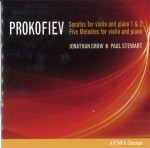 Toronto Symphony Orchestra concertmaster Jonathan Crow is joined by pianist Paul Stewart on Prokofiev’s Works for Violin and Piano, his latest CD on the ATMA Classique label (ACD2 2535). The recording was made in April 2008, though, when Crow was still concertmaster of the Orchestre Symphonique de Montréal. The three works here – the Sonatas for Violin and Piano No.1 in F Minor and No.2 in D Major and the Five Melodies – were all also featured on the recent 2-CD release of Prokofiev’s complete works for violin by James Ehnes, reviewed in this column just two months ago.
Toronto Symphony Orchestra concertmaster Jonathan Crow is joined by pianist Paul Stewart on Prokofiev’s Works for Violin and Piano, his latest CD on the ATMA Classique label (ACD2 2535). The recording was made in April 2008, though, when Crow was still concertmaster of the Orchestre Symphonique de Montréal. The three works here – the Sonatas for Violin and Piano No.1 in F Minor and No.2 in D Major and the Five Melodies – were all also featured on the recent 2-CD release of Prokofiev’s complete works for violin by James Ehnes, reviewed in this column just two months ago.
There is a warmth and clarity to Crow’s playing, as well as a nice range of tonal colour. The Sonata No.1 in F Minor, by far the major work on the disc, is given a powerful reading, and the D major sonata, a transcription of Prokofiev’s light-hearted Flute Sonata, showcases the brightness of Crow’s playing. Stewart is an excellent partner, and there is strong but sensitive playing from both performers throughout an excellent disc.
The recording was made in the acoustically superb Salle Françoys-Bernier hall at Domaine Forget in Saint-Irénée, Québec.
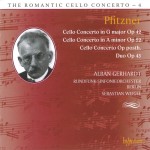 Several of the CDs in the outstanding Hyperion series Romantic Violin Concertos – currently at Volume 15 – have been reviewed in previous editions of this column, but Volume 4 in the companion Romantic Cello Concerto series is the first I have received; it features concertos by the German composer Hans Pfitzner, who lived from 1869 to 1949 (CDA67906).
Several of the CDs in the outstanding Hyperion series Romantic Violin Concertos – currently at Volume 15 – have been reviewed in previous editions of this column, but Volume 4 in the companion Romantic Cello Concerto series is the first I have received; it features concertos by the German composer Hans Pfitzner, who lived from 1869 to 1949 (CDA67906).
I have long known Pfitzner’s name in connection with his opera Palestrina, the work for which he is still mostly remembered, but it occurred to me that I couldn’t recall ever actually having heard any of his music. And what a loss that turns out to be, if the works on this revelatory CD are anything to go by. Pfitzner wrote three cello concertos: the Concerto in A Minor, Op.posth., is a student work from 1888 that was not performed in public until 1977; the Concertos in G major, Op.42 and A minor, Op.52, date from 1935 and 1943 respectively.
Don’t be put off by Pfitzner’s stern, dour face in his photographs: his music is firmly in the German late Romantic tradition of Brahms, Bruch and Humperdinck, and it really is gorgeous stuff – warm, rich, melodic, finely crafted, beautifully orchestrated, giving the soloist ample opportunity to display the instrument’s range and character.
The German cellist Alban Gerhardt is in his element here, and gets wonderful support from the Rundfunk-Sinfonieorchester Berlin under Sebastien Weigle. Violinist Gergana Gergova joins Gerhardt for the Duo Op.43 for Violin, Cello and Small Orchestra, a delightful work from 1937 that brings a marvellous and beautifully-recorded CD to a close.
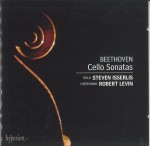 You’re always guaranteed a thought-provoking CD whenever cellist Steven Isserlis is the soloist, and his latest offering on Hyperion (CDA67981/2), a 2-CD set of the Beethoven Cello Sonatas (although Complete Works for Cello and Piano would be a more accurate title) is no exception.
You’re always guaranteed a thought-provoking CD whenever cellist Steven Isserlis is the soloist, and his latest offering on Hyperion (CDA67981/2), a 2-CD set of the Beethoven Cello Sonatas (although Complete Works for Cello and Piano would be a more accurate title) is no exception.
There are many performer pairings to choose from in recordings of these works, of course, but what makes this particular set so interesting is Robert Levin’s accompaniment on a copy of an 1805 fortepiano. The works consequently have a quite different sound, with the reduced volume and sustainability giving the keyboard an almost harpsichord-like quality, especially with the left-hand Alberti bass patterns and the heavy, almost percussive, low left-hand octaves. While it might reduce the volume, however, it certainly doesn’t reduce the scale of these works, which span Beethoven’s early, middle and late periods. In fact, the keyboard sound perfectly complements and contrasts the dark, rich sound of Isserlis’ 1726 Stradivarius cello. And what a sound it is: sweet and clear in the higher register, but strong and forceful – almost rough – in the lower register.
CD1 has the two Op.5 sonatas and the A major Op.69; CD2 has the two Op.102 sonatas together with three sets of Variations – on See the conqu’ring hero comes from Handel’s Judas Maccabaeus and on Ein Mädchen oder Weibchen and Bei Männern, welche Liebe fülen’ from Mozart’s Die Zauberflöte – and Beethoven’s own transcription of his Op.17 Horn Sonata.
The performances are outstanding, bristling with character throughout. Add the usual terrific booklet notes by Isserlis himself, and the almost 80 minutes per disc, and it’s simply impossible to give this set anything but the highest recommendation.
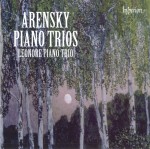 Britain’s Leonore Piano Trio is outstanding in the two Arensky Piano Trios (Hyperion CDA68015). Anton Arensky’s Piano Trio No.1 in D minor Op.32 was written in 1894 and, in keeping with the commemorative nature of the piano trio form established by Tchaikovsky some 12 years earlier, was conceived as a memorial to the cellist Karl Davidoff, the director of the St. Petersburg Conservatory during Arensky’s student days there. The cello consequently has a very prominent part in the Trio.
Britain’s Leonore Piano Trio is outstanding in the two Arensky Piano Trios (Hyperion CDA68015). Anton Arensky’s Piano Trio No.1 in D minor Op.32 was written in 1894 and, in keeping with the commemorative nature of the piano trio form established by Tchaikovsky some 12 years earlier, was conceived as a memorial to the cellist Karl Davidoff, the director of the St. Petersburg Conservatory during Arensky’s student days there. The cello consequently has a very prominent part in the Trio.
Pianist Tim Horton sets the stage with a beautiful opening; violinist Benjamin Nabarro adds a warm, sweet tone, especially in the lower register; and cellist Gemma Rosefield’s passionate playing leaves nothing to be desired. The Piano Trio in F Minor Op.73 dates from the early 1900s, not long before Arensky’s death in 1906 and at a time when the composer was in poor health. It’s another terrific work, and one that draws more outstanding playing from the Leonore ensemble.
Among Arensky’s pupils in his harmony class at the Moscow Conservatory was Sergei Rachmaninov, and the latter’s Vocalise is presented here in an arrangement by Rachmaninov’s friend Julius Conus, who was also one of Arensky’s students at the Conservatory. Everything about this outstanding CD is just right: the works themselves; the great ensemble playing; the interpretations; the excellent dynamics and phrasing; and the real passion and sensitivity displayed throughout. Add the excellent balance and sound quality, and it’s a real winner.
Berlin-based Chinese violinist Ning Feng is a new name to me, but it clearly shouldn’t be; he’s been active at a very high level for the best part of 10 years, and his three previous CDs – two of them solo recitals – on the Channel Classics label were issued to great critical acclaim.
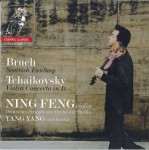 His latest offering on the same label pairs Bruch’s Scottish Fantasy with the Tchaikovsky Violin Concerto, with Yang Yang conducting the Deutsches Symphonie-Orchester Berlin (CCS SA 34913).
His latest offering on the same label pairs Bruch’s Scottish Fantasy with the Tchaikovsky Violin Concerto, with Yang Yang conducting the Deutsches Symphonie-Orchester Berlin (CCS SA 34913).
Ning has a bright, clear tone, and obviously finds no technical challenges in the music. He exhibits somewhat of a laid-back approach in the Bruch, avoiding any tendency to rush, but it does seem to be a bit emotionally detached at times. There’s the same approach in the Tchaikovsky, but with much better results. The sweet, singing tone is always present, but the constant feeling of holding back at the beginning of the faster, busy passages doesn’t halt the flow at all – in fact, it has just the opposite effect, allowing us to hear the details without a sense of rushing, and allowing the momentum to build naturally as the music progresses.
The recorded sound is fine, but the balance seems to be a bit strange at times; there are moments in the Bruch in particular when Ning seems to almost disappear.
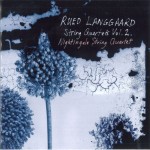 I was delighted to see that Volume 2 of the outstanding series of the complete String Quartets by Danish composer Rued Langgaard (1893-1952) has been released (DACAPO 6.220576). Volume 1 was reviewed in depth in this column in July 2012, at which time I noted that Denmark’s Nightingale String Quartet was simply superb in the first volume of a series of all nine quartets by a composer described in the excellent booklet notes as an eccentric outsider who was virtually ignored by the Danish musical establishment in his lifetime.
I was delighted to see that Volume 2 of the outstanding series of the complete String Quartets by Danish composer Rued Langgaard (1893-1952) has been released (DACAPO 6.220576). Volume 1 was reviewed in depth in this column in July 2012, at which time I noted that Denmark’s Nightingale String Quartet was simply superb in the first volume of a series of all nine quartets by a composer described in the excellent booklet notes as an eccentric outsider who was virtually ignored by the Danish musical establishment in his lifetime.
Most of Langgaard’s string quartets were written in his youth, between 1914 and 1925. This second volume features three works from the Great War years: Rosengaardsspil (Rose Garden Play) from 1918 (in a world premiere recording), String Quartet in A-flat major from 1918, and String Quartet No.4 “Sommerdage” (Summer Days) from 1914-18, revised in 1931. All three quartets use material inspired by Langgaard’s unrequited love for a young girl he met in the summer of 1913 while on holiday with his parents in Sweden; the house they stayed in was called “The Rose Garden.”
Once again, the performances by the prize-winning all-female Nightingale Quartet are outstanding – warm, passionate, expressive, and displaying great ensemble playing. I ended the review of Volume 1 by saying: “Beautifully recorded at the Royal Danish Academy of Music and issued on Denmark’s national record label, these performances are as close to definitive as you can get. Wonderful stuff, and I can’t wait to hear the rest of the series.” Well, two volumes down and one to go, and I’m still just as enthusiastic!



